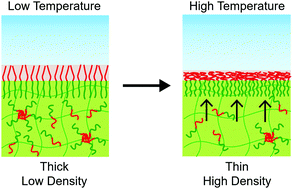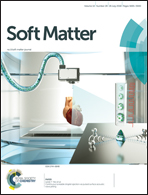A thermoresponsive dynamic polymer brush fabricated by the segregation of amphiphilic diblock copolymers
Abstract
A highly dense polymer brush was previously fabricated by the spontaneous segregation of amphiphilic diblock copolymers in an elastomer matrix into water and a hydrophobic polymer interface and named a ‘dynamic polymer brush’. We fabricated a lower critical solution temperature (LCST)-type thermoresponsive dynamic polymer brush by mixing polyisoprene-b-poly[tri(ethylene glycol)methyl ether methacrylate] (PI-b-PME3MA) into a polystyrene-b-polyisoprene-b-polystyrene (SIS) elastomer. The LCST of PME3MA in water is 52 °C. The structure of the polymer brush was determined at several different temperatures using neutron reflectivity. With increasing temperature, the brush thickness of the LCST-type thermoresponsive dynamic polymer brush decreases, similar to the conventional fixed brush with the LCST-type thermoresponse. However, the graft density of the dynamic polymer brush surprisingly increases with increasing temperature. The change of the brush density of the conventional fixed polymer brush is not allowed. However, we observed for the first time that dynamic polymer brushes uniquely respond to increasing temperature with increasing brush densities.



 Please wait while we load your content...
Please wait while we load your content...